February 1
lecture 5 B cell module
recap of lecture 4
- state of nonresponsiveness
- antibody binds to B cells and macrophages engulf them?
- apoptosis -
programmed cell death
- can be triggered
- program is cell intrinsic (all cells have it)
- when send such strong signal of auto reaction -> trigger apoptosis
B cell dev stages in the bone marrow coincide with the steps of VDJ gene recombination
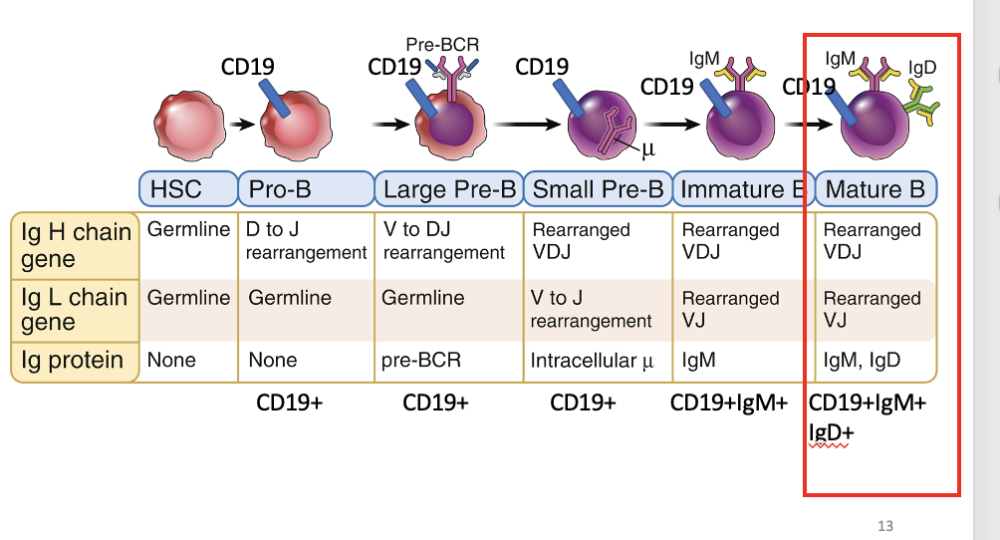
Mature B cell has
- rearranged VDJ heavy chain
- rearranged VJ light chain
- has IgM and IgD antibodies
- has CD19
B cell activation
3 types of mature B cells
- diff subsets of B cells -> divisions of labor
mature B cells: 3 types
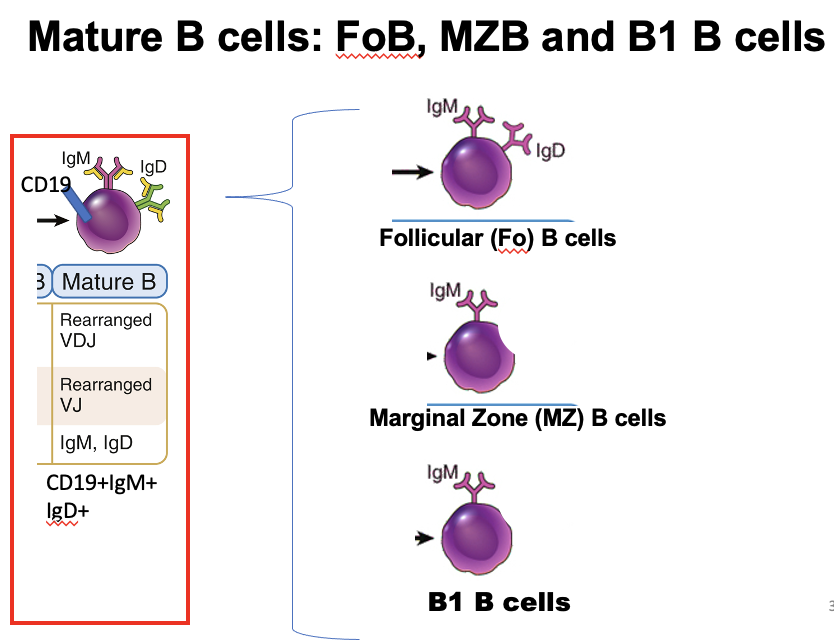
FoB
- follicular B cells
- follicle is structure in lymph node and spleen where immune cells congregate - and roam body
- most B cells are follicular zone B cells (most abundant)
- IgM + IgD
MZB
- marginal zone B cells
- sit around where blood goes/etc from spleen
- so can capture antigens
- 1/10th of splenic B cells
B1
- Can make antibodies when nothing is around
- provide natural immunity
- smth abt fetal
- in fluidic parts of the body
functional consequences of B cell activation in antibody responses
...
division of labor among 3 mature B cell types
2 major ways B cells can activate
T cell dependent antibody responses
- follicular B cells
- activated with the help of T cells
T cell independent antibody responses
- stimulate marginal zone B cells and B1 B cells
- dont need help of T cells
repetitive epitopes in an antigen can activate B cells to produce antibodies
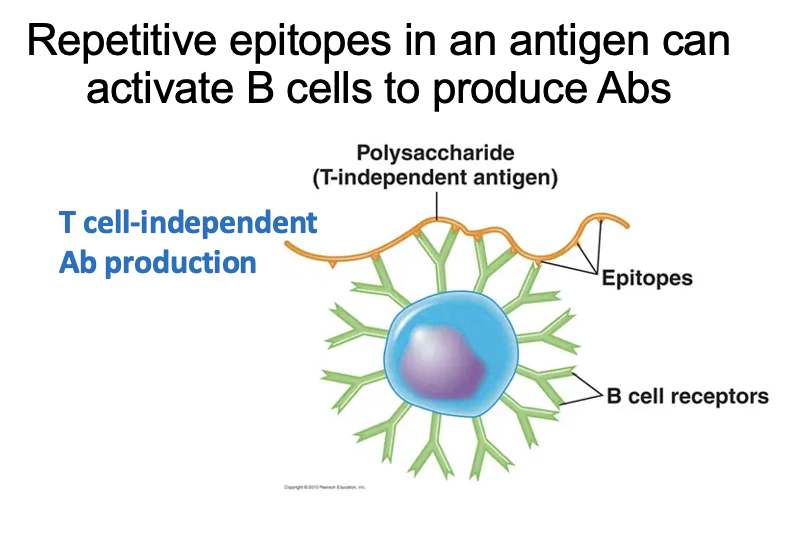
- for T cell independent responses
- repetitive epitopes can activate cell and make it proliferate, not changing quality of antibody
- polysaccharides and nucleic acids - repeated structures
- when receptors cluster
- enough to initiate biochemical responses to send B cells into
proliferate/expand
- sends such powerful signal that it triggers antibody production/B cell response
T cell independent B cell activation
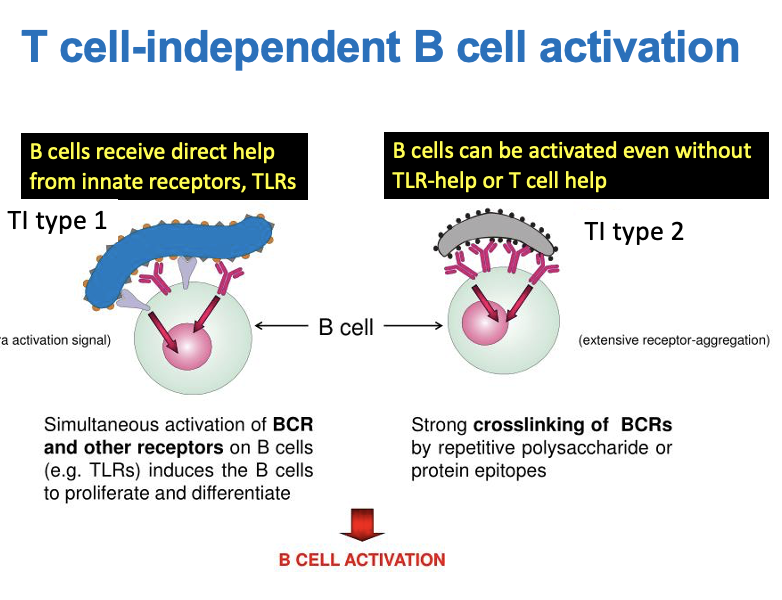
- 2 types of these antigens
- trigger B cells of
repetitive epitopes
- B cells receive direct help from innate receptors, TLRs
- simultaneous activation of BCR and other receptors on B cells (ex: TLRs) induce the B cells to proliferate and differentiate
- extra activation signal
- cross linking of BCR: type 2 T
cell independent immune response
- strong cross linking of BCRs by repetitive polysaccharides or protein epitopes
- extensive receptor aggregation
- trigger B cells of
repetitive epitopes
-> B cell activation
- all life made of protein, fats, carbs, nucleic acids, etc. Thus, antigens have these
This may be a mechanism to provide protection during time adaptive immunity is maturing
- during the first few days, it would be innate response, and possibly this response
Repetitive epitope can bring together a lot of BCR(?) – can be so powerful that change machinery in B cell, and undergo the changes that make it produce antibodies
mechanism of B cell activation by BCR signaling
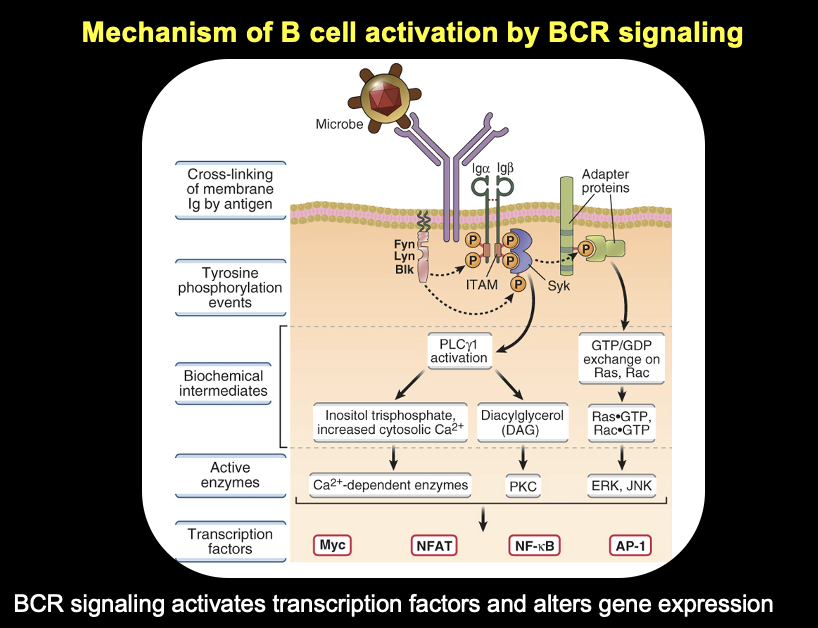
Signal transduction
BCR signaling activates transcription factors and alters gene expression
*know BCR or TCR don’t have inherent ability to activate B or T cell on its own
-> so it associates w/ other proteins that can do that
*** antigen receptors don’t have inherent ability to activate
- when phosphorylation occurs w/ tyrosine kinases
- get phosphorylated quickly
-> eventually activate transcription factors to irreversibly activate B cell
- bc genes turned on and used for immune response
- process important – biochemistry of B cell changes upon seeing antigen
- if possible to activate this receptor massively, then all the changes that occur are possible to lesser extent
What are T cell-independent antigens and how do they activate
B cells?
What type of B cells are activated by T
cell-independent antigens
pause for activity
Repetitive epitope can bring together a lot of TCRs – can be so powerful that change machinery in B cell, and undergo the changes that make it produce antibodies
B1 and marginal B cells can be triggered
T cell-dependent ans T cell-indepfnent antibody production
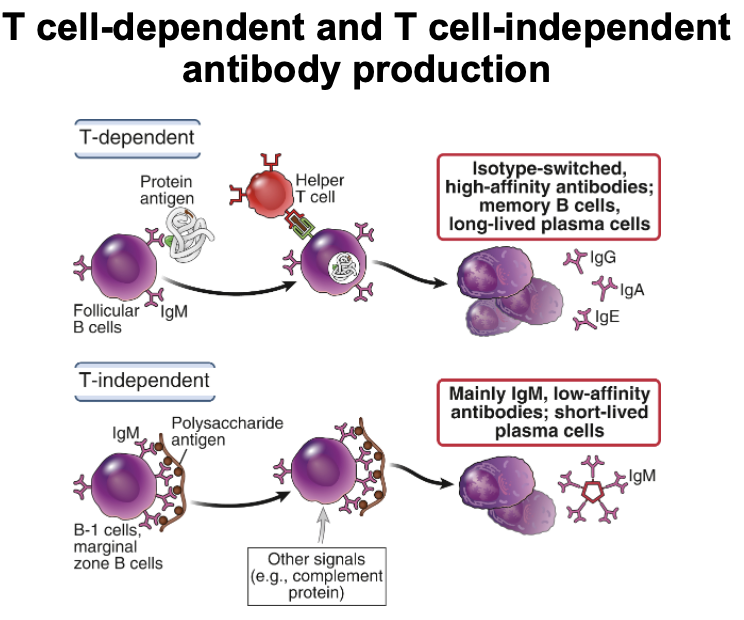
T-dependent
- BCR or antibody molecule can see linear or nonlinear epitopes
bc antibody structure sees shapes (not sequence)
- - can see many types of molecules
- - same antigen can
be taken up by T cell in shape of a peptide
- - this
presentation of antigen is key in gaining T cell help for
helping B cells make antibody
- - make IgG, IgA, IgE
- - NOT IgM
- - make IgG, IgA, IgE
- - this
presentation of antigen is key in gaining T cell help for
helping B cells make antibody
- - B cells activated from antigen, and T cells also activated - how do they meet w/ same specificity for same antigen? - this can happen anywhere
T-independent
dont fully understand, go over this???
B cell receptor signaling functionally alters B cells: expand clonally and solicit T cell help as APC
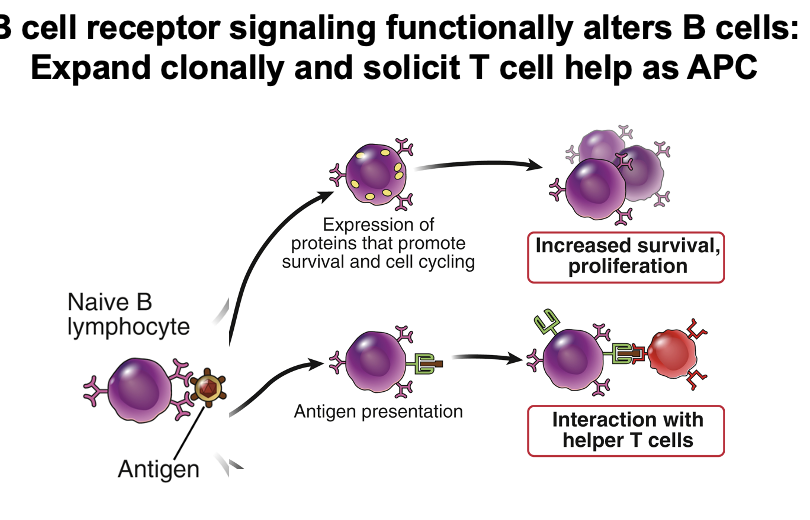
Naïve B cell – starts to express proteins
- also are better survivors than before encountered antigen
- they can also present antigen to T cells, by showing it a small peptide
- the T cell will then help the B cell
naive B cell
- -> expression of proteins that promote survival
and cell cycling
- -> increased survival, proliferation
- antigen
presentation
- interaction w/ helper T cells
B cell receptor signaling functionally alters B cells:
(continued, just 3 more possible functions after BCR signaling)
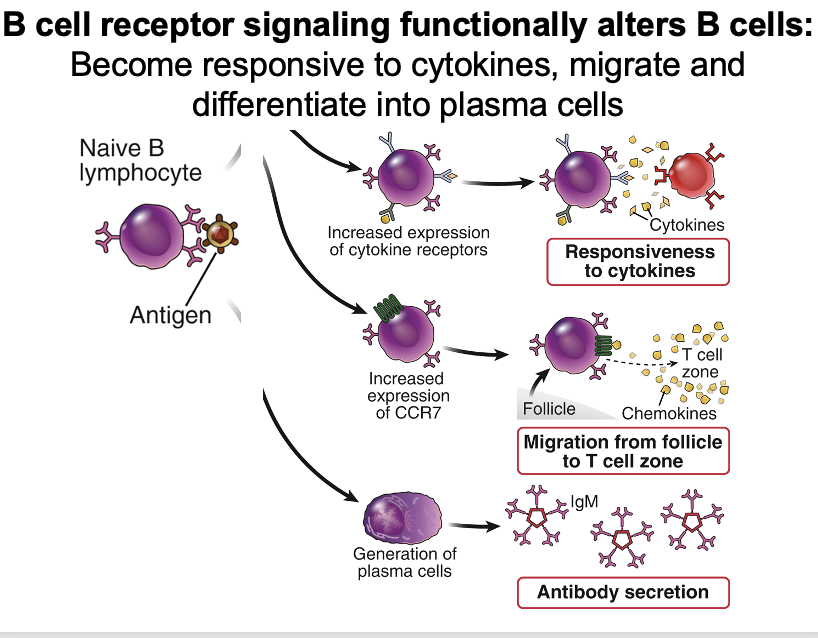
become responsive to cytokines, migrate and differentiate into plasma cells
- naive B cell + antigen
- inc expression of cytokine
receptors
- responsiveness to cytokines
- inc expression of
CCR7
- migration from follicle to T cell zone
- generation of plasma cells
- antibody secretion
- inc expression of cytokine
receptors
When B cells see antigen, express new molecules on surface (cytokine receptors)
- when B cells see antigens, become alert bc now can respond to soluble molecules did not see before
- can go to where T cells are
- B cells can become plasma cells -> secrete antibodies
BCR signal transmission is a process that changes the B cell a lot – can never go back
phases of B cell activation during an immune response
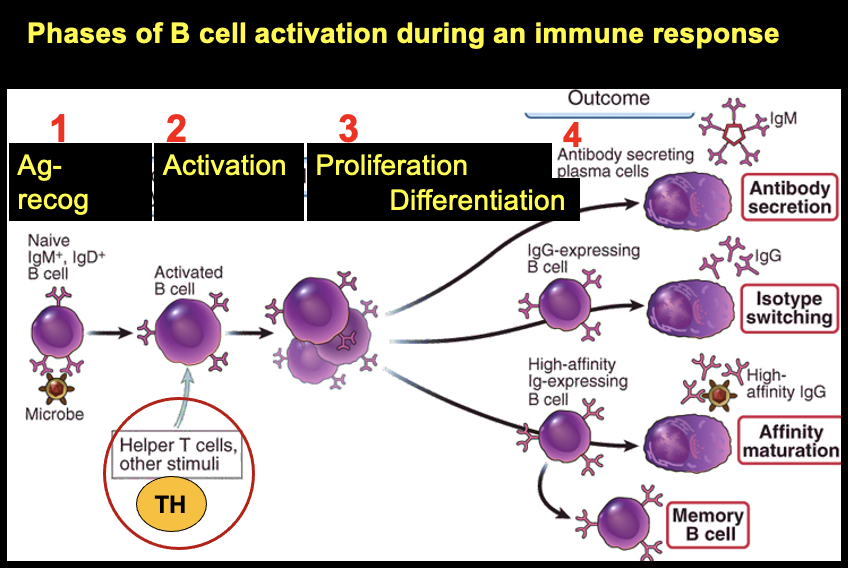
- antigen recognition
- by naive IgM IgD B cell
- activation of B cell
- + helper T cell/other stimuli
- proliferation/differentiation
- antibody secreting plasma cells -> antibody secretions
- IgG expressing B cell -> isotype switching
- high affinity Ig-expressing B cell -> affinity maturation and memory B cell
extracellular vs intracellular pathogens
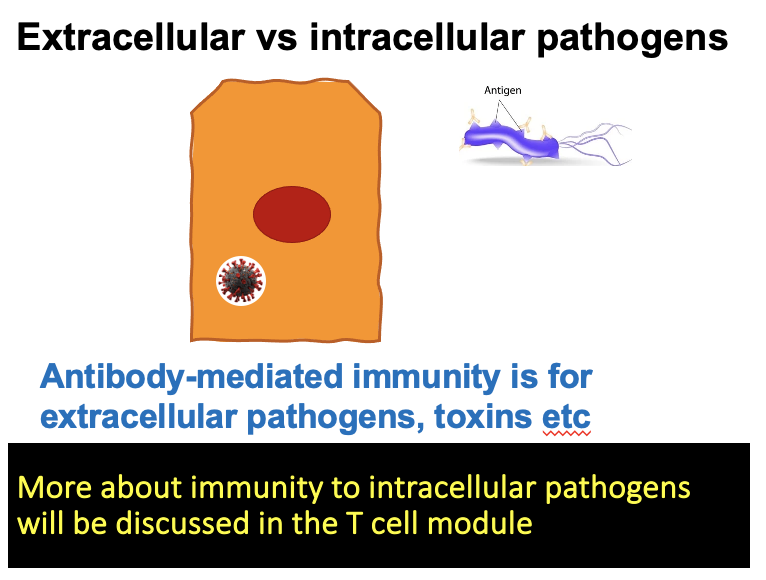
antibody mediated immunity is for extracellular pathogens, toxins, etc.
more abt immunity to intracellular pathogens discussed in T cell module
How do T cells see antigen?
T cells limited – only see peptides (protein antigens)
2 types of microbes generally
- live in cell
or
- extracellular
Antibodies cannot get into cells
Only way to cure intracellular pathogens -> by killing infected cells
Killer T cells – kill infected cells
B and T cells see antigens independently
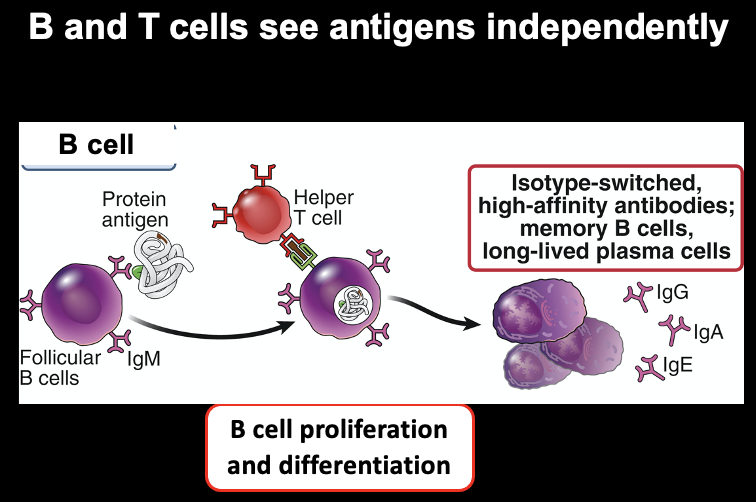
follicular B cell + antigen
- -> then helper T cell
- -> then isotype switched, high affinity antibodies; memory B cells, long-lived plasma cells
antigen-specific B and T cells find each other in immune cell hubs (lymph nodes, tonsils, spleen, etc.)
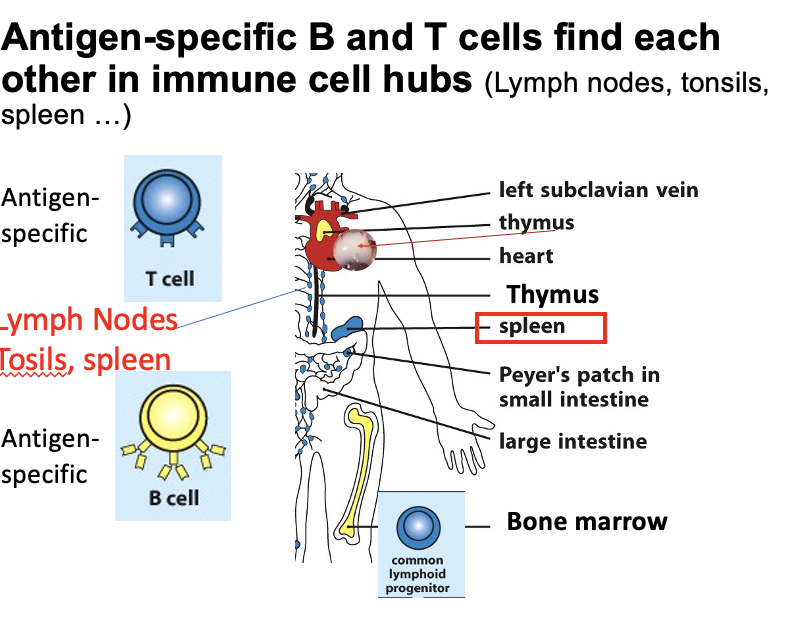
How B and T cells find each other
Lymph nodes thru bodies
- circulate immune cells constantly
If lymphocytes going thru tissues constantly, are likely to find each other
- chances of a unique B and T cell seeing each other increases because of heavy traffic of immune cells thru the body
B and T cells see antigens differently
...
T cells want their antigens (peptides) to be served on a platter
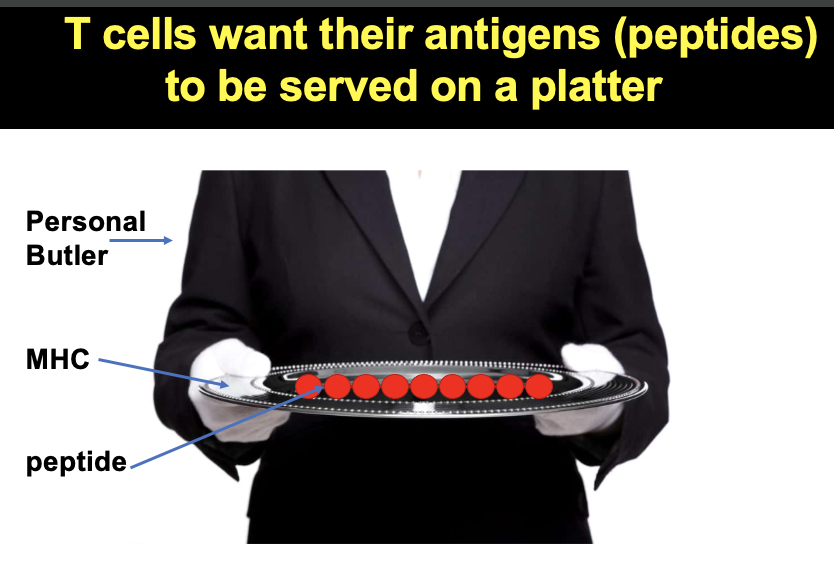
System T cells use to recognize antigen
- they cannot find floating antigens
(must be presented)
See peptide displayed on MHC molecule (presenting the antigen to the T cell)
T cell see antigen only in this fashion, and must be presented by antigen presenting cell from own body’s cells (personal butler)
infected cells process Ag (peptides) and MHC molecules serve them to T cells
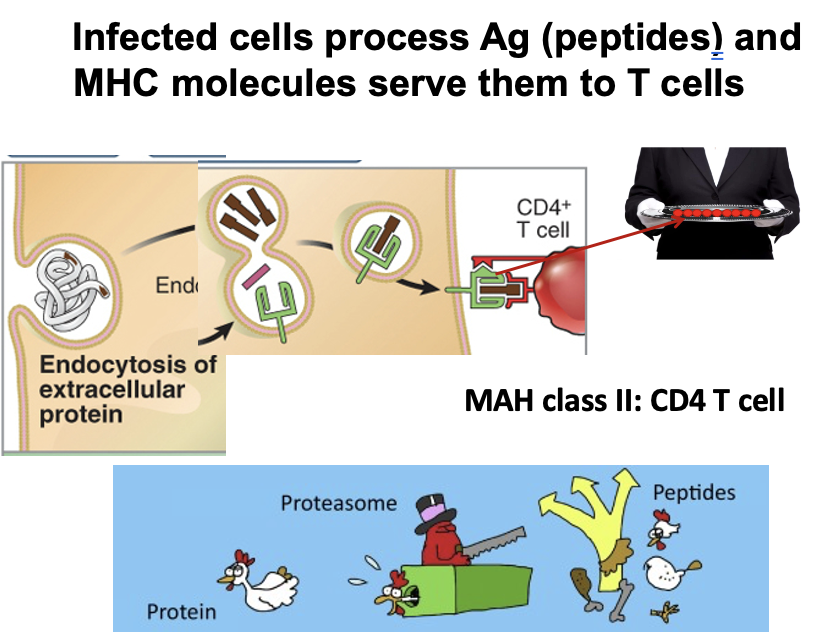
How looks inside the antigen presenting cell (dendritic cell, macrophage, etc)
What happening in cell
- pathogen enter, broken down into pieces, peptides displayed on MHC molecule and presented to T cell
this process = antigen processing
T cells can only see peptide after being processed by our cells (antigen presenting cells)
Very diff from B cells – can see directly
B cells are antigen-presenting cells to solicit T cell help in the GCs
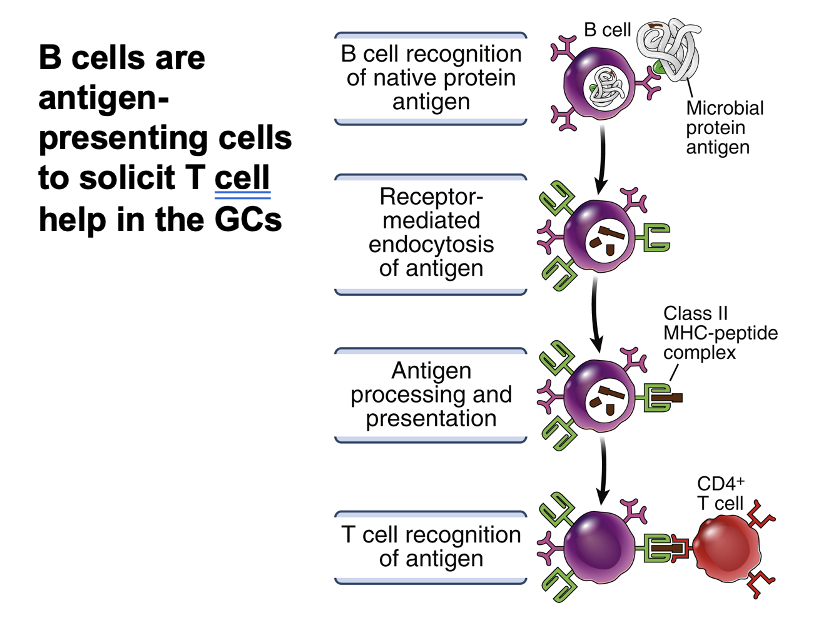
- B cell recognition of native protein antigen
- receptor-mediated endocytosis of antigen
- antigen processing and presentation
- T cell recognition of antigen
B cells can chop up the antigen, make peptide, and present them to the T cell
= glue between antigen specific T and B cell
= how they find each other specifically
-> Allows them to cooperate
-> This occurs in lymph nodes, tonsils, spleen, in the GC
B cells promote and solicit T cell help for their activation
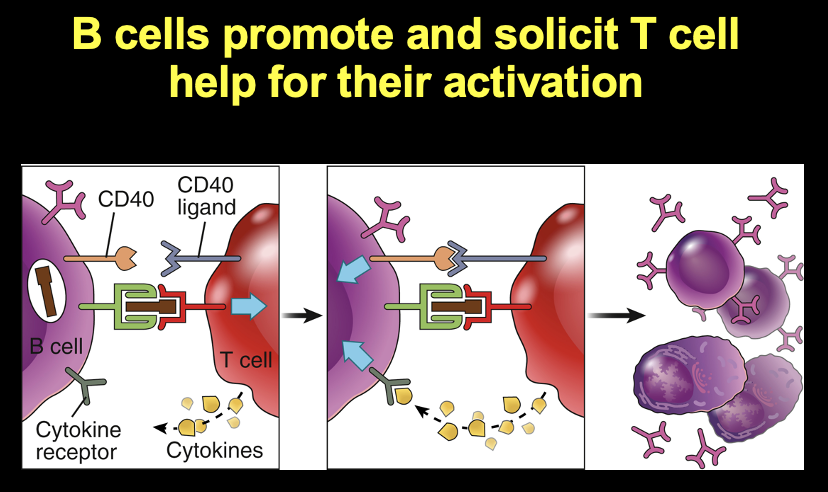
Interaction btw B and T cells
B cell present antigen to T cell
B cell is specific to the antigen
Activates T cell (innate antigen presenting cell can do the same thing to activate the T cell) + start making cytokines
B cells make cytokine receptors once activated
- so the cytokines made by cytokines are recognized by B cells
Activated T cell starts making protein receptor called CD40 ligand (on T cell surface)
B and T cell must physically interact – make junction similar to neurons talking
They connect for hours -> further and further activated (T cell more and more activated by peptide, and B cell more and more activated by cytokines from T cell)
3 signals
1. B cell presenting antigen to T cell
2. CD40 ligand and CD40 interacting
3. Cytokines form T cell to B cell
= the cells interacting. CD40 signal potent for clonal expansion -> T cell makes B cell clonal expansion occur more rapidly
- T cell help is superior in B cell activation, compared to B cells on their own
= in this process, make a LOT of B cells, and thus more plasma cells and antibodies
B cell Ab response requires Ag and a 2nd plus signals
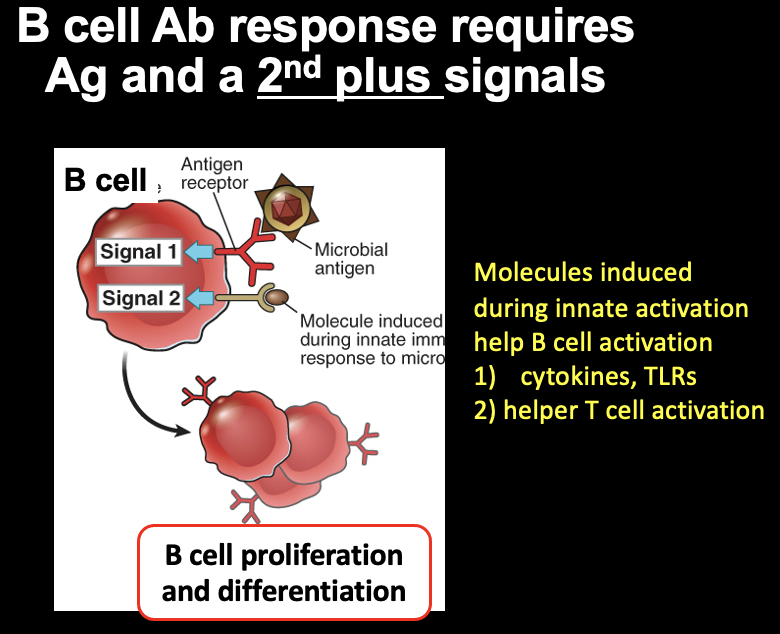
hypothesis says B cell must receive 3 signals in order to undergo clonal expansion + make antibodies
- usually provided by T cells
- 3rd is important, but not
on this slide
- cytokines, TLRs
- CD40 ligand/receptor interaction
- B cell presenting antigen to T cell
B cells interact physically with T cells to make higher quality and quantity antibody response
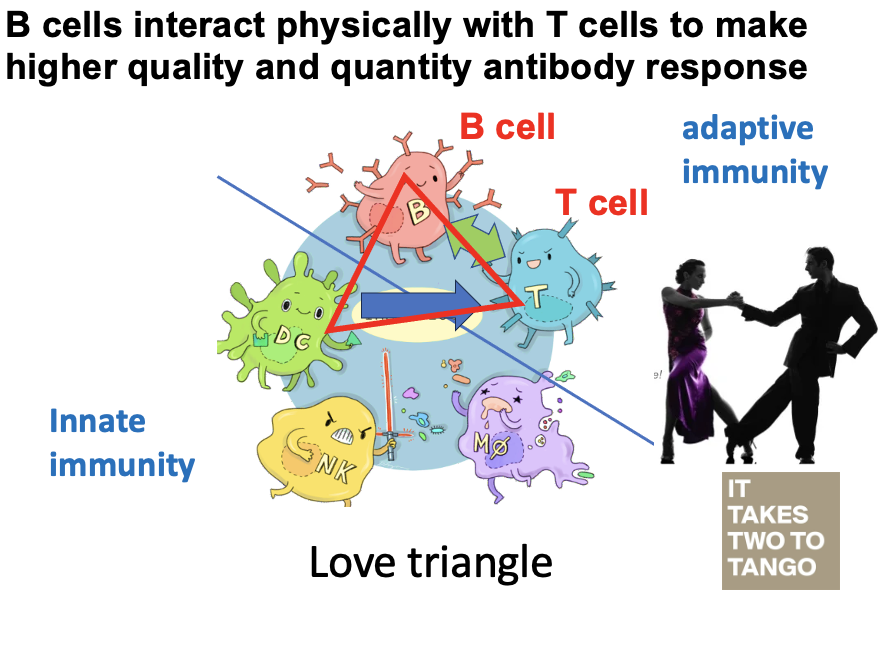
takes 2 to tango
B and T cells must interact to make humoral response optimally
physical interaction required to make potent B cell receptor
= ultimately helps B cells and activates T cells
when doe sB/T cell antigen presentation happen, and when is it done by innate cell instead?
- initiation of immune response by antigen presenting cell, can be done by B or innate cell
- depends on chance and which cell meets first
What is required for the full activation of B cells during a T cell-dependent immune response?
pause for activity
the germinal center reaction
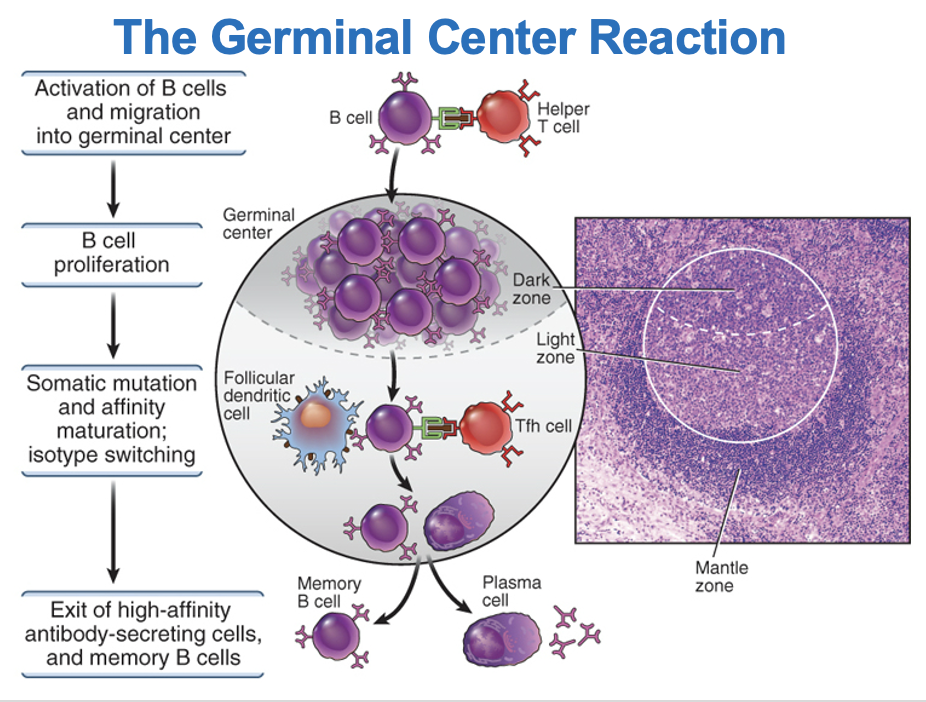
activation of B cells and migration into germinal center
-> B cell proliferation
-> somatic mutation and affinity maturation; isotype switching
-> exit of high-affinity antibody-secreting cells and memory B cells
where does specific B and T cell interaction take place?
- once B and T cells see antigen and recognize each other, can
go on to form new structure that did not exist prior to infection
(germinal center)
- to optimize immune response
optimization
B cell is tested for how well it binds w/ antigen -> if good, then multiplies
-
many cycles of testing and multiplication btw the light and
dark zone
-
makes possible to select better binding B cell clones
for antigen binding
- many B cells go on to be memory cells or make antibodies
- = why memory response is effective, bc have gone thru germinal center testing to have cells that respond/bind very well to antigen
- why secondary response is more powerful, robust, precise, and faster (same for vaccines, not just natural immunity)
-
makes possible to select better binding B cell clones
for antigen binding
what changes in B cells that increase their affinity?? answer: affinity maturation
whats happening in the germinal center? isotype switching and somatic hypermutation
affinity maturation
- B cell activation by CD40L induces activation induced deaminase (AID) that promotes SHM
Occurs thru somatic hypermutation
- CD40 interaction makes B cells start making new enzyme (activation induced deaminase (AID)) – responsible for mating mutations in binding site of antibody
- in the junctions where variability occurs, creates NEW mutations ONLY after B cell fully mature and part of immune response
- carried out by AID specifically
antibody affinity maturation by somatic hypermutation
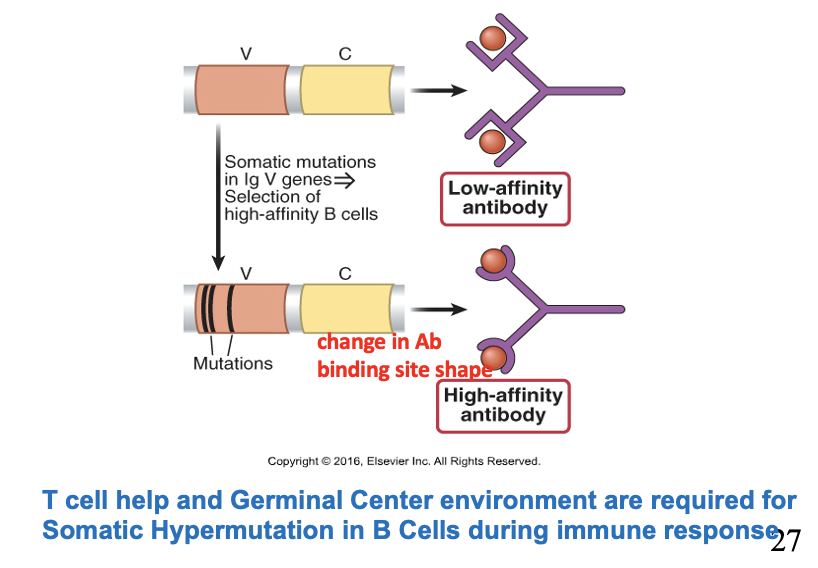
somatic mutations lead to selection of high affinity B cells (lower affinity change to high affinity)
- mutations cause change in antibody binding site shape
- T cell help and germinal center environment are required for somatic hypermutation in B cells during immune responses
Happens in the binding site, where variable regions are
In both heavy and light chains, but occurs more in heavy chains
This process perfects the antibody – originally is not as perfect as it can be
- further maturation of affinity of antibody
- happens only with T cell interaction’s CD40 interaction, which starts this AID being used, and thus leading to this affinity maturation
affinity maturation of primary antibody by SHM (somatic hypermutation)
- IgM primary antibody -> somatic hypermutations in binding site of antibody
selection of high affinity B cells in the germinal centers (GCs)
B cells with somatically mutated Ig V genes and Igs with varying affinities for antigen
B cells with high affinity membrane Ig bind antigen on follicular dendritic cells (FDCs) and present antigen to helper T cells
B cells that recognize antigen
for selection of high affinity antibodies
- select only the best binders
- best affinity -> go on
- if not high affinity -> apoptosis
during this process - start expressing death receptor
- if T cell not attached to B cell, the death receptor is lost?
- T cells can protect B cells from death?